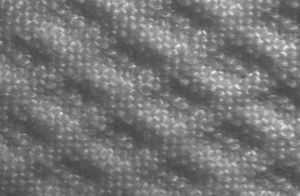Piqué (weaving)

Piqué, or marcella, refers to a weaving style, normally used with cotton yarn, which is characterized by raised parallel cords or fine ribbing. Twilled cotton and corded cotton are close relatives.
The weave is closely associated with white tie, and some accounts even say the fabric was invented specifically for this use. It holds more starch than plain fabric, so produces a stiffer shirt front. Marcella shirts then replaced earlier plain fronts, which remain a valid alternative. Marcella's use then spread to other parts of the dress code and it is now the most common fabric used in the tie and waistcoat of white tie. A knit fabric with a similar texture is used in polo shirts.
Marcella weaving was developed by the Lancashire cotton industry in the late 18th century as a mechanised technique of weaving double cloth with an enclosed heavy cording weft.[1] It was originally used to make imitations of the corded Provençal quilts made in Marseille, the manufacture of which became an important industry for Lancashire from the late 18th to the early 20th century.[1] The term "marcella" is one of a number of variations on the word "Marseille".[2]
Pique fabrics are a type of dobby construction. Piques may be constructed in various patterns such as cord, waffle, honeycomb and birdseye piques. These fabrics require the addition of extra yarns, called stuffer yarns. These stuffer yarns are incorporated into the back of the fabric to give texture and added depth to the fabric design. Some piques may be made using the Jacquard attachment on the loom. Although made of 100% cotton today, cotton-silk blends and even pure silk versions were made in the past and in a variety of weaves. [3]
References
- ↑ 1.0 1.1 Quilting - see, trapunto, Quilting in the North Country, Needlework through the Ages, retrieved 2010-05-02
- ↑ Atkins, Jacqueline M. (2001), "From lap to loom: The transition of Marseilles white work from hand to machine", The Chronicle of the Early American Industries Association, Inc, retrieved 2010-05-02
- ↑ From "The Textiles Handbook" by Dr Rebecca Davis and Dr Carol Tuntland. 1996 Plycon Press
| ||||||||||||||||||||||||||||||||
